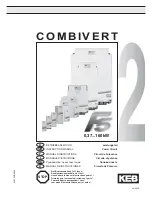
IP address recovery
In the event that the device is not visible on the network, the network has changed, or the static IP address details have been lost,
reset the BirdDog back to its default settings by following the factory reset procedure.
BirdDog name
You can name each unit with a friendly name that makes sense for each production (Camera 1, Camera 2, etc). This name will
appear on any NDI receiver when it looks for video coming from Mini over the network. The name must not include any special
characters and can be any combination of ‘a-z, 1-0, and –‘.
Note: no uppercase characters are valid.
On NDI receiving devices, the device will present as a source as follows:
birddog-name [HDMI] when the unit is set to automatic input.
SYSTEM
System update
The converter is updateable via the web interface. Please check the below address regularly to ensure you have the latest
firmware available for your device.
Having the latest firmware ensures you have all the latest features and performance updates to get the most out of Flex 4K
Converters:
bird-dog.tv/firmware-updates
After downloading the latest firmware release, navigate to the settings tab on the web configuration console and click on Choose
file… select the firmware update file and press the update button.
NDI NETWORK SETTINGS
9
Video Mode
All available sources are listed in the drop down menu in the DECODE SETTINGS section of the web interface, select the desired
source and press APPLY to begin receiving this source.
You can switch between any available sources on the network by choosing them from the drop down menu and pressing APPLY
again.
Note. If you are unable to successfully receive a source, please double check that the video format and frame rate are ones that
are supported by your unit.
YUV Colour Space
Built into BirdDog Flex is colour space conversion, some NDI computer sources provide video in RGB or YUV colour space. If you
experience inverted colours on your computer-based source swap RGB for YUV colour space.
NETWORK
Device naming
When your device is first powered on it defaults to the naming convention as described in the web configuration panel section of
this manual.
It is possible to change the name along with the network settings to better suit your environment.
Configuration method
You can configure your device to operate on the network with a dynamic (DHCP) IP address or a fixed address.
For smaller networks DHCP networking is generally suitable, however larger networks with managed operations will often deter-
mine each device needs to have a dedicated and static IP address.
DHCP IP address
DHCP is set as the network configuration by default for Mini.
Static IP address
To enable a static IP address, change configuration method to static and fill in the details required in Address, Mask and Gateway.
Particular attention should be paid to the Address and Mask fields as incorrect information entered will result in device not being
visible on the network and a factory reset will be required in order to recover the unit.
Multicast
Multicast is especially useful for use-cases that require a single source to be received on multiple receivers simultaneously.
Utilising Muliticast offloads the distribution of the NDI A/V packets from the BirdDog Flex 4K to the network infrastructure. You
should take care to ensure your network is specifically configured to support Multicast as using it on an ill-prepared network can
create unintended network problems.
MultiTCP
MultiTCP is a new NDI transport method that allows users to send NDI video over poor network topography such as WAN (Wide
Area Networks) without experiencing issues such as packet loss and lost frames. In the past in order to send NDI video over a
WAN the UDP transport was the only option available. UDP solved some issues of WAN applications by allowing the NDI video
to travel without dropping masses of frames but results in dropped packets being missed which could cause unstable video. UDP
also places more performance demands on devices sending and receiving the signal.
MultiTCP employs a new method of sending TCP packets whereby it opens a mass of TCP connections over the WAN and uses
them in a ‘round robin’ manner, this allows each individual TCP connection enough time to acknowledge the receiving packet,
confirm nothing is lost and prepare for the next one before it’s sent the next TCP packet in the round robin. This is similar to a
RAID setup in traditional storage.
OPERATION
Factory resetting your unit
If you have lost any network settings or cannot find your BirdDog Flex device on the network, you can perform a network factory
reset.
Simply depress the reset button located next to the RS-232 port for 5 seconds until the Halo tally illuminates flashing red. The unit
will be accessible as per factory settings approximately 10 second later.
Preferred Receive Method
TCP
TCP is the default transmission method for NDI, it operates well within local networks with predictable latency and limited jitter.
BirdDog recommends that TCP be used for typical applications, and only using alternative transports for specific reasons.
UDP
UDP is recommended for networks where there is extended latency from one end to the other. The nature of UDP means that it
does not need to receive a confirmation of each packet being received successfully – vastly improving performance on distance
WANs. UDP can have some consequences f there are other issues on the network such as jitter or lost packets as it will not inher-
ently re-sent a lost packet.




























